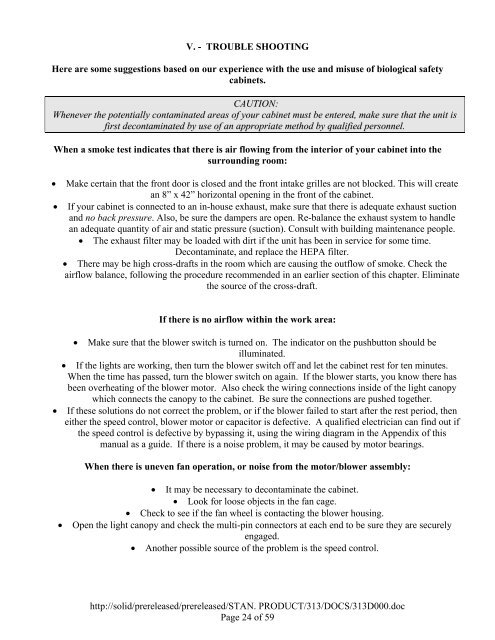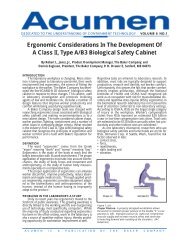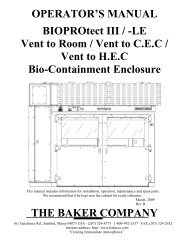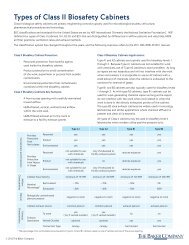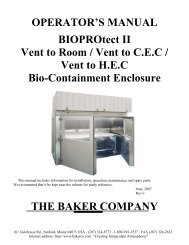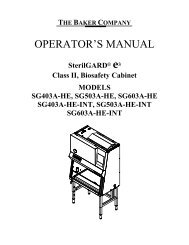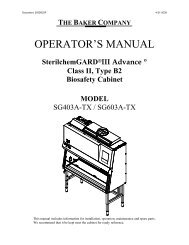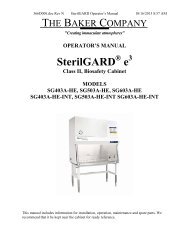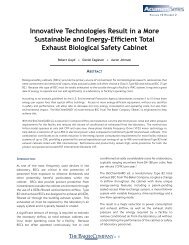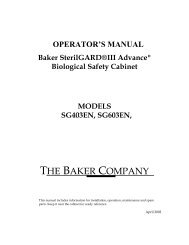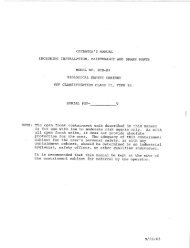OPERATOR'S MANUAL BIOPROtect II JR Vent to ... - Baker Company
OPERATOR'S MANUAL BIOPROtect II JR Vent to ... - Baker Company
OPERATOR'S MANUAL BIOPROtect II JR Vent to ... - Baker Company
You also want an ePaper? Increase the reach of your titles
YUMPU automatically turns print PDFs into web optimized ePapers that Google loves.
V. - TROUBLE SHOOTING<br />
Here are some suggestions based on our experience with the use and misuse of biological safety<br />
cabinets.<br />
CAUTION:<br />
Whenever the potentially contaminated areas of your cabinet must be entered, make sure that the unit is<br />
first decontaminated by use of an appropriate method by qualified personnel.<br />
When a smoke test indicates that there is air flowing from the interior of your cabinet in<strong>to</strong> the<br />
surrounding room:<br />
• Make certain that the front door is closed and the front intake grilles are not blocked. This will create<br />
an 8” x 42” horizontal opening in the front of the cabinet.<br />
• If your cabinet is connected <strong>to</strong> an in-house exhaust, make sure that there is adequate exhaust suction<br />
and no back pressure. Also, be sure the dampers are open. Re-balance the exhaust system <strong>to</strong> handle<br />
an adequate quantity of air and static pressure (suction). Consult with building maintenance people.<br />
• The exhaust filter may be loaded with dirt if the unit has been in service for some time.<br />
Decontaminate, and replace the HEPA filter.<br />
• There may be high cross-drafts in the room which are causing the outflow of smoke. Check the<br />
airflow balance, following the procedure recommended in an earlier section of this chapter. Eliminate<br />
the source of the cross-draft.<br />
If there is no airflow within the work area:<br />
• Make sure that the blower switch is turned on. The indica<strong>to</strong>r on the pushbut<strong>to</strong>n should be<br />
illuminated.<br />
• If the lights are working, then turn the blower switch off and let the cabinet rest for ten minutes.<br />
When the time has passed, turn the blower switch on again. If the blower starts, you know there has<br />
been overheating of the blower mo<strong>to</strong>r. Also check the wiring connections inside of the light canopy<br />
which connects the canopy <strong>to</strong> the cabinet. Be sure the connections are pushed <strong>to</strong>gether.<br />
• If these solutions do not correct the problem, or if the blower failed <strong>to</strong> start after the rest period, then<br />
either the speed control, blower mo<strong>to</strong>r or capaci<strong>to</strong>r is defective. A qualified electrician can find out if<br />
the speed control is defective by bypassing it, using the wiring diagram in the Appendix of this<br />
manual as a guide. If there is a noise problem, it may be caused by mo<strong>to</strong>r bearings.<br />
When there is uneven fan operation, or noise from the mo<strong>to</strong>r/blower assembly:<br />
• It may be necessary <strong>to</strong> decontaminate the cabinet.<br />
• Look for loose objects in the fan cage.<br />
• Check <strong>to</strong> see if the fan wheel is contacting the blower housing.<br />
• Open the light canopy and check the multi-pin connec<strong>to</strong>rs at each end <strong>to</strong> be sure they are securely<br />
engaged.<br />
• Another possible source of the problem is the speed control.<br />
http://solid/prereleased/prereleased/STAN. PRODUCT/313/DOCS/313D000.doc<br />
Page 24 of 59


